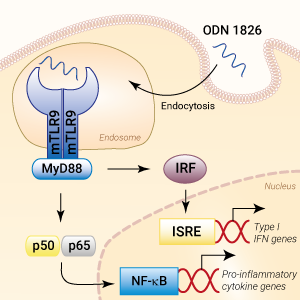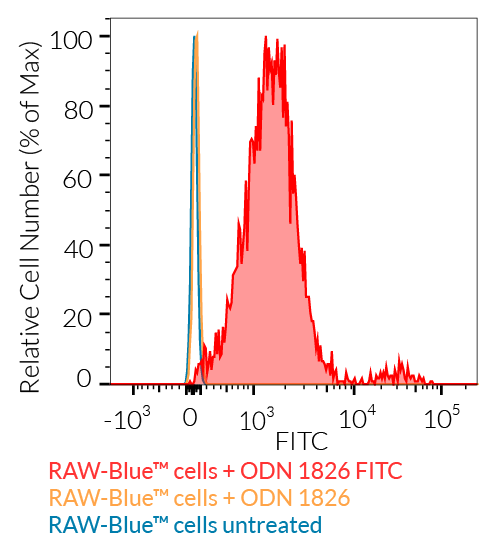ODN 1826 FITC
| Product | Unit size | Cat. code | Docs. | Qty. | Price | |
|---|---|---|---|---|---|---|
|
ODN 1826 FITC Class B - FITC-labeled ODN 1826 |
Show product |
50 µg |
tlrl-1826f
|
|
FITC labeled CpG oligonucleotide - Murine TLR9-preferred ligand
 InvivoGen also offers:
InvivoGen also offers:
• TLR reporter cells: HEK293, RAW, THP-1 cells
• TLR research tools: Antibodies, Inhibitors, etc.
ODN 1826 FITC is the labeled version of ODN 1826, a Class B CpG oligonucleotide (ODN) with a preference for the mouse Toll-like receptor 9 (mTLR9). ODN 1826 is a short synthetic single-stranded DNA molecule containing unmethylated CpG dinucleotides (CpG motifs). It contains a full phosphorothioate backbone and is nuclease-resistant. These synthetic unmethylated CpG motifs mimic microbial DNA and act as immunostimulants via TLR9.
Mode of action
Stimulatory CpG ODNs are internalized and activate the endosomal receptor TLR9. Activation of TLR9 triggers NF-κB- and interferon regulatory factor (IRF)-mediated pro-inflammatory responses upon the recognition of unmethylated cytosine-phosphorothioate-guanosine (CpG) forms of DNA [1-3]. Unmethylated CpG dinucleotides are a hallmark of microbial (bacterial, viral, fungal, and parasite) DNA, as well as mitochondrial self-DNA [3, 4]. Class B (also called Type K) CpG ODNs, such as ODN 1826, contain a full phosphorothioate backbone with one or more CpG dinucleotides. They strongly activate B cells but weakly stimulate IFN-α secretion in plasmacytoid dendritic cells [5].
InvivoGen's ODN 1826 FITC is the labeled version of the ODN 1826, a strong mTLR9 agonist verified using our HEK-Blue™ reporter cell lines expressing human or mouse TLR9 (see figures).
ODN 1826 FITC can be used to evaluate CpG ODN binding, cellular uptake, and localization by confocal laser-scanning microscopy (excitation 495 nm, emission 520 nm) (data not shown) or flow cytometry(see figure). The labeled ODN retains the biological activity.
Key features of ODN 1826 FITC
- Potent activator of mouse TLR9
- FITC labeled
- Synthetic ODN with unmethylated CpG motifs
- Each lot is functionally tested
![]() Get more information about CpG ODNs Classes.
Get more information about CpG ODNs Classes.
![]() Read our review on TLR9 agonists: double-edged sword for immune therapies.
Read our review on TLR9 agonists: double-edged sword for immune therapies.
References
1. Kumagai Y. et al., 2008. TLR9 as a key receptor of the recognition of DNA. Adv. Drug. Deliv. Rev. 60(7):795-804.
2. Heinz L.X. et al., 2021. TASL is the SLC15A4-associated adaptor for IRF5 activation by TLR7-9. Nature. 581(7808):316-322.
3. Kayraklioglu N. et al., 2021. CpG oligonucleotides as vaccine adjuvants. DNA Vaccines: Methods and Protocols. Methods in Molecular Biology. Vol. 2197. p51-77.
4. Kumar V., 2021. The trinity of cGAS, TLR9, and ALRs: guardians of the cellular galaxy against host-derived self-DNA. Front. Immunol. 11:624597.
5. Krieg A.M. et al., 1995. CpG motifs in bacterial DNA trigger direct B-cell activation. Nature. 374(6522):546-9.
Specifications
Specificity: murine TLR9 agonist
Working concentration: 1-5 μM
ODN 1826 sequence : 5’-tccatgacgttcctgacgtt-3’ (20 mer)
Note: Bases are phosphorothioate (nuclease resistant).
Spectral Properties of FITC:
- Excitation λ max: 495 nm
- Emission λ max: 520 nm
Quality control:
- ODN 1826 FITC has been validated by flow cytometry and cellular assays.
- The absence of bacterial contamination (e.g. lipoproteins and endotoxins) has been confirmed using HEK-Blue™ TLR2 and HEK-Blue™ TLR4 cell
Contents
- 50 μg (7.31 nmol) lyophilized ODN 1826 labeled with FITC at the 3’ terminus
- 1 ml sterile endotoxin-free water
![]() ODN 1826 FITC is shipped at room temperature.
ODN 1826 FITC is shipped at room temperature.
![]() Store at -20°C. Resuspended product should be stored at -20°C and protected from light.
Store at -20°C. Resuspended product should be stored at -20°C and protected from light.
![]() Product is stable for 6 months.
Product is stable for 6 months.
![]() Protect from light. Avoid repeated freeze-thaw cycles.
Protect from light. Avoid repeated freeze-thaw cycles.
Details
CpG ODNs
Synthetic oligodeoxynucleotides containing unmethylated CpG motifs (CpG ODNs), such as ODN 1018, have been extensively studied as adjuvants [1]. These CpG motifs are present at a 20-fold greater frequency in bacterial DNA compared to mammalian DNA [2]. CpG ODNs are recognized by the Toll-like receptor 9 (TLR9), which is expressed on human B cells and plasmacytoid dendritic cells (pDCs), thereby inducing Th1-dominated immune responses [3]. Pre-clinical studies, conducted in rodents and non-human primates, as well as human clinical trials, have demonstrated that CpG ODNs can significantly improve vaccine-specific antibody responses [1]. Three types of stimulatory CpG ODNs have been identified, types A, B, and C, which differ in their immune-stimulatory activities [4-5].
Toll-like receptor 9
The Toll-like Receptor 9 (TLR9) is an endosomal receptor that triggers NF-κB- and interferon regulatory factor (IRF)-mediated pro-inflammatory responses upon the recognition of unmethylated cytosine-phosphorothioate-guanosine (CpG) forms of DNA [6-8]. Unmethylated CpG dinucleotides are a hallmark of microbial (bacterial, viral, fungal, and parasite) DNA, as well as mitochondrial self-DNA [8,9]. These TLR9 agonists can be mimicked by synthetic oligonucleotides containing CpG motifs (CpG ODNs), which have been extensively studied to improve adaptive immune responses in the context of vaccination [6,8].
TLR9 is mainly expressed in subsets of Dendritic Cells and B cells of all mammals. In rodents, but not in humans, TLR9 is also expressed in monocytes and macrophages [8]. The structure of the receptor varies by 24% between human TLR9 (hTLR9) and mouse TLR9 (mTLR9) [8]. They recognize different CpG motifs, the optimal sequences being GTCGTT and GACGTT for hTLR9 and mTLR9, respectively [10].
References:
1. Steinhagen F. et al., 2011. TLR-based immune adjuvants. Vaccine 29(17):3341-55.
2. Hemmi H. et al., 2000. A Toll-like receptor recognizes bacterial DNA. Nature 408:740-5.
3. Coffman RL. et al., 2010. Vaccine adjuvants: Putting innate immunity to work. Immunity 33(4):492-503.
4. Krug A. et al., 2001. Identification of CpG oligonucleotide sequences with high induction of IFN-alpha/beta in plasmacytoid dendritic cells. Eur J Immunol, 31(7): 2154-63.
5. Marshall JD. et al., 2005. Superior activity of the type C class of ISS in vitro and in vivo across multiple species. DNA Cell Biol. 24(2):63-72.
6. Kumagai Y. et al., 2008. TLR9 as a key receptor of the recognition of DNA. Adv. Drug. Deliv. Rev. 60(7):795-804.
7. Heinz L.X. et al., 2021. TASL is the SLC15A4-associated adaptor for IRF5 activation by TLR7-9. Nature. 581(7808):316-322.
8. Kayraklioglu N. et al., 2021. CpG oligonucleotides as vaccine adjuvants. DNA Vaccines: Methods and Protocols. Methods in Molecular Biology. Vol. 2197. p51-77.
9. Kumar V., 2021. The trinity of cGAS, TLR9, and ALRs: guardians of the cellular galaxy against host-derived self-DNA. Front. Immunol. 11:624597.
10. Bauer S. et al., 2001. Human TLR9 confers responsiveness to bacterial DNA via species-specific CpG motif recognition. Proc Natl Acad Sci USA, 98(16):9237-42.







